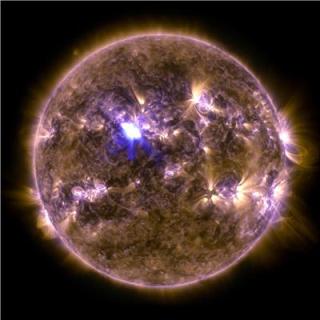Aug 20 2014
A major new collaboration between the Astrophysics Research Centre (ARC) at Queen’s University Belfast and American space agency NASA is set to investigate ‘solar flares’ and their potential to cause disruption here on Earth.
 M6flare-orig_full credit:NASA
M6flare-orig_full credit:NASA
Essentially explosions in the Sun’s atmosphere, solar flares result in significant increases in ultra-violet radiation. While the physics behind this phenomenon is still unknown, the increased UV radiation and the associated solar storms can disrupt radio communication and GPS, with potentially dangerous knock-on effects for a range of activities including air-traffic control and search-and-rescue missions. Solar storms can also be associated with the visual spectacle known as the Northern Lights which is caused by charged particles streaming from the Sun.
NASA, in conjunction with the Catholic University of America, has awarded $330,000 to the project which will be headed up by internationally renowned Queen’s researcher, Dr Ryan Milligan, and straddle Queen’s and NASA’s Goddard Space Flight Center outside Washington DC.
Dr Milligan said: “Solar flares can have significant effects on modern life. For example, they can throw GPS off by quite significant distances – tens of metres – so considering how many services now rely on GPS, that’s a lot of potential for chaos. As a society, we are starting to come to terms with the significance of all of this. The UK Met Office has recently begun research into ‘space weather’ while the insurance brokers Lloyds of London have classified solar flares as a major insurance risk. My job is to understand the physics behind these explosions. The more we can understand how and why they happen, the more we can try to predict them and hence, to mitigate their effects.”
Director of the Astrophysics Research Centre at Queen’s, Professor Stephen Smartt said: “Over the last few years, Ryan’s work has had major international impact and the NASA grant he was awarded shows his growing reputation as a renowned scientist. It is a pleasure to have him at Queen's as a visiting fellow and for us to collaborate with him on this project. Ryan is an excellent student mentor and we hope to offer opportunities for local students to travel to the Goddard Space Flight Center to experience research in a NASA institute.”
Dr Milligan’s research is based on data from the ‘Solar Dynamics Observatory’ spacecraft, NASA’s flagship Living With A Star Program mission, which was launched into space almost five years ago to analyse the interaction of the Sun with the Earth’s atmosphere.